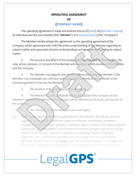Event Sponsorship ROI: Structuring Measurable Outcomes in Your Agreement
Sponsorships can be a game-changer for events, providing critical funding, marketing support, and brand credibility. However, securing sponsors isn’t...
8 min read
LegalGPS : Apr. 14, 2025
Securing a big-name sponsor can transform an event, organization, or business. A well-structured sponsorship agreement does more than bring in funding—it creates a mutually beneficial partnership where both sides see value.
So how do you structure a sponsorship agreement that makes big brands excited to sign on? It starts with understanding their priorities, offering creative sponsorship tiers, and outlining clear benefits in a legally sound agreement.


Legal GPS Pro
Protect your business with our complete legal subscription service, designed by top startup attorneys.
A strong sponsorship deal starts with understanding what sponsors value most. While it’s easy to assume they’re just looking for logo placement and visibility, major brands want something more: strategic brand alignment, audience engagement, and measurable ROI.
One of the biggest reasons sponsorship proposals fall flat is because they’re written from the perspective of the organization seeking funding rather than the sponsor. Simply listing benefits like "Your logo on our website" or "Recognition in our event program" isn’t enough to attract a top-tier sponsor.
High-profile brands want sponsorship opportunities that:
A regional sports tournament pitches a major tech company for sponsorship, offering logo placement on event banners, T-shirts, and brochures. The tech company declines—because while their brand gets visibility, they’re not getting meaningful engagement with their target customers.
Now, imagine the sports event rethinks its offer and instead proposes an interactive gaming lounge sponsored by the tech company, complete with hands-on demos of their latest products. That’s a win-win. The event gets funding, and the sponsor gets a direct way to engage attendees with their brand—making it a far more attractive deal.
Before drafting your sponsorship agreement, research what the sponsor actually values.
When your sponsorship offer solves a need for the sponsor, you drastically increase your chances of securing the deal.

Boost Your Brand with Sponsorship Now!
Legal GPS templates are drafted by top startup attorneys and are fully customizable🛠️.
Trusted by 1000+ businesses to close secure deals.
Once you understand what sponsors want, the next step is structuring sponsorship tiers that cater to different levels of investment. Instead of the outdated Gold, Silver, and Bronze model, think about packaging sponsorships in a way that directly connects with sponsor goals.
Not every sponsor has the same budget, goals, or audience engagement strategy. A high-profile corporation may want naming rights and maximum exposure, while a smaller company might prefer targeted social media placements.
By offering flexible sponsorship options, you:
Instead of generic sponsorship levels, create value-driven tiers based on what sponsors get in return.
This is your highest-value package, offering the sponsor full brand integration into your event or initiative. This could include naming the event after them (e.g., "The Nike Innovation Summit"), top-tier branding, and VIP speaking opportunities.
For sponsors looking to target specific parts of your event, offer category-based sponsorships such as:
Some sponsors may be more interested in digital exposure rather than in-person branding. Offer options like:
A music festival struggling to attract major sponsors ditched its traditional sponsorship tiers and instead created engagement-driven packages.
One of the new options? A sponsored influencer experience, where the sponsor would fund high-profile social media influencers to attend the festival and post live content featuring the sponsor’s products. The result? A beverage company that previously declined the festival’s sponsorship offer jumped on board, eager for the influencer exposure that aligned perfectly with their marketing strategy.
Once you’ve defined creative sponsorship tiers, your agreement should:
A well-structured sponsorship agreement makes both parties feel confident that they’re getting a great deal—leading to stronger partnerships and more long-term sponsorships.


Legal GPS Pro
Protect your business with our complete legal subscription service, designed by top startup attorneys.
A sponsorship deal is only as strong as the contract behind it. Even if both sides agree on terms verbally, a vague or poorly written agreement can lead to confusion, missed obligations, and a frustrated sponsor who never returns. Clarity is key to ensuring both parties understand what’s expected and what they’ll receive in return.
A well-structured agreement removes ambiguity by clearly outlining what the sponsor is getting in return for their investment. This could include logo placement, speaking opportunities, social media promotions, or product integrations. If exclusivity is part of the deal—such as being the only beverage brand at an event—this needs to be explicitly stated.
Without clear definitions, sponsors may feel they aren’t getting what they paid for, leading to disputes or a refusal to renew.
Payment details should be spelled out in full, specifying the sponsorship fee, deadlines, and refund policies. Some sponsors prefer installment payments rather than a lump sum upfront, so offering flexibility can make your agreement more attractive.
Additionally, if your event spans multiple phases or marketing campaigns, payment schedules can be structured to align with key milestones.
Many sponsors want measurable proof that their sponsorship is yielding results. Your contract should address how success will be tracked, whether through audience engagement, impressions, lead generation, or direct conversions.
Some agreements include post-event reports detailing how the sponsorship performed. Even if not required, offering this data strengthens sponsor confidence and increases the likelihood of renewal.
Big-name sponsors are highly protective of their brand image. The agreement should outline how and where their logo, messaging, and branding will appear. If marketing materials involve co-branded promotions, confirm whether the sponsor has final approval rights before distribution.
Without these safeguards, you risk conflicts that could damage the partnership.
An e-sports tournament partnered with a major gaming hardware brand, offering prominent logo placement on livestreams and merchandise. However, the contract lacked a brand approval clause.
A week before the event, the sponsor discovered their logo was being placed alongside a competing brand’s promotion, creating a direct conflict of interest. Because the agreement didn’t provide clear approval rights, the issue escalated into a legal dispute instead of a simple fix.
Had the agreement included an approval process for branding materials, the problem could have been prevented entirely.
To ensure your sponsorship agreement is both clear and enforceable, consider using a legally sound template or consulting an attorney. A well-drafted agreement provides confidence for both parties and increases the likelihood of long-term sponsorship success.
One of the biggest missed opportunities in sponsorship agreements is treating sponsors as one-time investors rather than long-term partners. The time and effort required to secure a sponsorship are significant, so retaining sponsors year after year is far more valuable than constantly searching for new ones.
A long-term sponsorship provides stability and credibility while often leading to larger investments over time. If a sponsor sees sustained value, they are more likely to:
To achieve this, sponsorship relationships need to be actively nurtured, not just revisited when it’s time to ask for money again.
If the agreement guarantees brand visibility, audience engagement, or exclusive rights, those commitments must be met without exception. Even minor oversights can damage trust and prevent a renewal.
Sponsors are investing in your ability to execute the partnership professionally, so a failure to deliver on promised benefits can hurt your credibility.
High-profile sponsors, particularly large corporations, expect data-backed proof that their sponsorship was successful. Even if your contract doesn’t require post-event reporting, offering insights into audience reach, engagement levels, and brand visibility helps demonstrate ROI.
A well-prepared report showing the impact of the sponsorship makes renewal discussions much easier. If the data shows positive results, sponsors are far more likely to reinvest.
A sponsorship relationship shouldn’t end when the campaign or event is over. Keeping sponsors engaged throughout the year strengthens the partnership and increases the likelihood of a long-term commitment.
Consider sending periodic updates about your organization’s progress, highlighting moments when their sponsorship had a real impact, or inviting them to exclusive networking opportunities where they can connect with other sponsors and stakeholders.
A nonprofit initially secured a one-year sponsorship from a major bank for its annual fundraising gala. Instead of simply thanking the sponsor and waiting until the following year to request another investment, they stayed engaged year-round.
Each month, the nonprofit sent updates showing how sponsorship funds were being used. The bank’s executives were invited to exclusive VIP networking events, and the nonprofit highlighted the sponsor’s involvement in press releases and marketing materials.
By the time renewal discussions came up, the sponsor was already deeply invested in the partnership. The bank not only renewed its sponsorship but signed a five-year deal at double the original investment.
To encourage long-term sponsorships, consider structuring your agreement with built-in renewal opportunities. Offering incentives for multi-year commitments—such as discounted renewal rates or additional promotional perks—can encourage sponsors to extend their partnership.
Another effective approach is first-right renewal clauses, which give sponsors the option to continue their sponsorship before you seek new sponsors. This creates a natural path toward long-term partnerships while ensuring sponsors don’t feel pressured into immediate commitments.
By focusing on relationship-building rather than transactional sponsorships, you’ll attract and retain high-profile sponsors, ensuring sustainable success.
Attracting major sponsors isn’t just about securing funding—it’s about creating a sponsorship agreement that delivers real value to both sides. A well-structured agreement should:
By following these principles, you’ll make your sponsorship opportunities significantly more attractive, leading to stronger, more sustainable sponsorships.
If you need a legally sound, customizable sponsorship agreement template, check out our sponsorship template to ensure your agreements not only secure funding but also build lasting partnerships.
The biggest question now is, "Do I need a lawyer for this?” For most businesses and in most cases, you might not need a lawyer for simple contract issues. Instead, many business owners rely on Legal GPS Pro to help with their legal needs.
Legal GPS Pro is your All-In-One Legal Toolkit for Businesses. Developed by top startup attorneys, Pro gives you access to 100+ expertly crafted templates including operating agreements, NDAs, and service agreements, and an interactive platform. All designed to protect your company and set it up for lasting success.

Legal GPS Pro
Protect your business with our complete legal subscription service, designed by top startup attorneys.
| Premium Template Single-use Template |
Legal GPS Pro Unlimited Access, Best Value |
|
|
| Get Template | Learn More |
| Trusted by 1000+ businesses | |

Sponsorships can be a game-changer for events, providing critical funding, marketing support, and brand credibility. However, securing sponsors isn’t...

The way sponsorships work has changed dramatically in the social media era. Traditional sponsorships focused on physical branding—logo placements at...

Navigating the world of sponsorship agreements can be challenging, but you're not alone in this journey. We're here to guide you through the ins and...